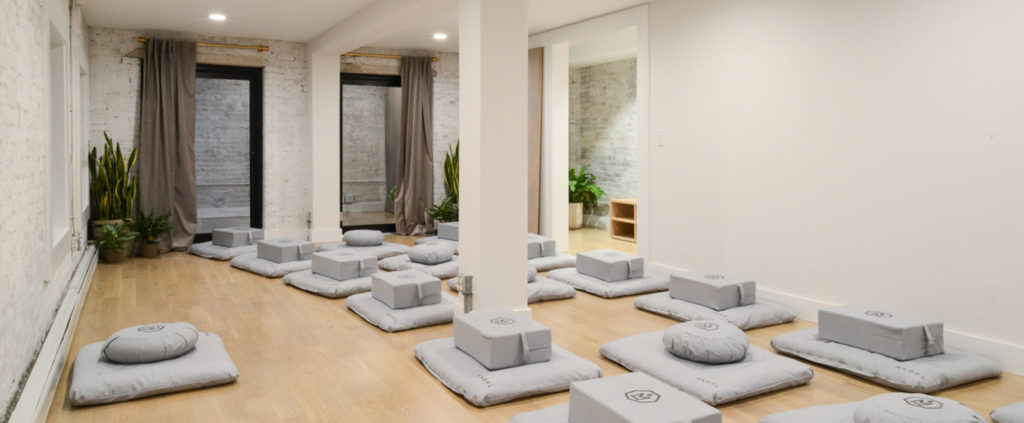
This article was originally posted on Taste The Style.
We all know what sound is and we all know what therapy is, but what happens when you combine the two? As a college senior muddling through millennial woes — i.e. the emotional major plot twist from this last election; watching Tinder derail my generation from old-fashioned, meaningful dating; trying to get my life together because the real world is around the corner. Yes, the list goes on for my adolescent troubles, but I stumbled across meditation – literally, I stumbled.
I have a secret spot on my campus to go to when the library is crowded or when I need peace and quiet. The Multi-faith Center is quiet — there are wall dividers, stain glass windows, not to mention it has outlets, which are hard to come by when everyone is charging their phone or laptop; it’s the best place to crash or chill.
One day, I went to go watch Netflix on my laptop and to my surprise, I saw a group of people sitting in a circle. Although I’m more of a dog person, curiosity indeed killed the cat. The group looked like they were coming to a close, so I grabbed a seat and listened in. They were talking about their experiences with meditation — eureka, it was a meditation group. I became intrigued by what they were saying and decided to join the following week.
https://www.instagram.com/p/B1UuxY5AsWz/
In the group, I learned how much we are NOT in tune with what’s going on in our own bodies. Being in the moment — like, truly being in the moment — is harder than you think. To contemplate about nothing, except breathing, to solely focus on the present and pick up the sensations of your body without your mind wandering from what you’re going to eat for dinner to the funny Instagram video you forgot to favorite — believe me, it’s not easy, but it’s fulfilling.
I knew that I was a chronic over-thinker but I didn’t realize how detrimental not focusing on myself was aside from the facade of always being “ok,” feeling “fine,” or doing “good;” answers like that always seem to have two sides to the story. The first time I meditated, I was able to go to a place where I never went before: I blacked out while still being 100 percent conscious and feeling safe yet peaceful. I thought about nothing for at least five minutes, I transported myself to a place where I wasn’t being just me, but just being. It was amazing and I felt like I unlocked something magical within myself.
https://www.instagram.com/p/B2AYWnFAwJC/
I have never thought about meditating or even considered it until I ran into that meditation group but I’m so grateful for fate doing a job well done. I didn’t understand meditation and saw it as just a thing people did. But man, those people were really onto something. Meditation has taught me to harness my best qualities and accept the woes and tribulations of life. The leader best explained it as: “Imagine your body is a house.” For some reason I pictured a beach house — I don’t even like sand — but waves are supposed to be meditative. “Picture your thoughts being people, knocking on your door and asking to come inside, let them in bad or good.” I then pictured a huge dining room table with bomb food and me sitting at the head of the table with all my thoughts and emotions sitting together. I acknowledged all of them, I let all of them in, I did not turn one “person” away from my doorstep. Whoop, there it is — acceptance in its purest form.
https://www.instagram.com/p/BzVwJYfAKgT/
As far as your mind wandering, it’s okay, you don’t need to beat yourself up for that. My leader, who’s great at creating imagery in explaining things, describes our mind-wandering as a cute, yet mischevious little kitten who keeps trying to get out of its bed. All you have to do is pick the kitten up and place it back in its bed, no matter how many times it wants to get up and run around, you must be gentle and understand that that’s what curious kittens do.
Just like this analogy, you should treat your thoughts the same way, when you start to think about your terrible morning train delay, stress about a deadline, or even daydream about something great, don’t get upset with yourself for drifting. Just pick up where you left off and re-focus on breathing and being in the present. It’s easy to think you are “here,” but in reality, you’re never really “here.” Meditation can remedy that.
Meditation is one of the greatest things that I was able to discover as a millennial; I was able to detach myself from technology and focus on the present — most importantly, focus on me. So, when I first heard of sound therapy, I knew it had something to do with meditation but it wasn’t until I truly experienced it with Sara Auster at MNDFL that I was able to really get a mental feel for it.
I had the pleasure of interviewing Auster after attending one of her classes at MNDFL. Whether you’re already a meditation freak like me or want to try something new, this one-of-a-kind class is the way to go. Scroll below to see the full interview.
https://www.instagram.com/p/Bvg-cShHaM_/
For those who are new, can you give us insight on what sound therapy is?
A Sound Bath is an improvised meditative concert that supports states of deep relaxation where stress release and healing can occur. A gentle yet powerful experience for the mind and body. The experience begins with each person lying down on a comfortable mat often with a blanket and an eye mask. After a few minutes of guided focus on the breath, the remainder of the experience is filled with different sounds and frequencies being introduced in succession. The sounds are created by a variety of instruments including tuning forks, gongs, Shruti box, Himalayan, and crystal singing bowls, chimes, and voice.
The goal of the experience is to invite deep rest and relaxation and explore self-inquiry.
Sound therapy is also known as sound healing. What does it heal and what are the key benefits of sound therapy?
Sound therapy, which may also be referred to as sound healing, uses overtone emitting instruments, often tuned to particular frequencies. These instruments can include tuning forks, gongs, Himalayan and crystal singing bowls and the human voice. The particular combinations and patterns of frequencies affect our brain waves, thereby altering our consciousness, and can be used to alleviate symptoms of anxiety, depression, insomnia and other ailments.
I prefer not to call myself a “sound healer.” The term “healer” implies that one person is doing something to another person. I believe that the body has the ability to heal itself. By creating a safe and comfortable environment and holding space for people, I am setting up the conditions for natural healing to occur. When we downshift to our parasympathetic nervous system, we can access deep relaxation, and that’s when we heal.
What advice can you give for sound therapy beginners?
Do your research. Make sure that the person facilitating your experience has studied sound therapy. Also, know that there are a lot of different options out there these days and everyone reacts differently to sound and vibration. Take the time to find someone that resonates with you.
How to do/ incorporate sound therapy on-the-go or at home?
I have a few short recordings available at Soundcloud and over 90 minutes of recorded music available for purchase.
–
Feature image via MNDFL

